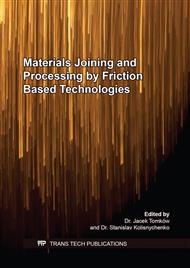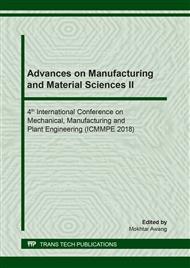[1]
Alder BJ, Wainwright TE. Studies in molecular dynamics. I. General method. Journal of Chemical Physics. 1959; 31(2): 459 – 466.
Google Scholar
[2]
Anonymous. Molecular Dynamics. https://en.wikipedia.org/wiki/Molecular_dynamics Retrieved July 2, (2018).
Google Scholar
[3]
McCammon JA, Gelin BR, Karplus M. Nature. 1977; 267: 585−590.
Google Scholar
[4]
Raymond K, Giovanni C. Molecular dynamics: an account of its evolution. Theory and Applications of Computational Chemistry. 2005; 425-441.
Google Scholar
[5]
Ansari R, Ajori S, Rouhi S. Characterisation of the mechanical properties of polyphenylene polymer using molecular dynamics simulations. Physica B. 2016; 481: 80-85.
DOI: 10.1016/j.physb.2015.10.029
Google Scholar
[6]
Kurban M, Erkoc S. Mechanical properties of CdZnTe nanowires under uniaxial stretching and compression: A molecular dynamics simulation study. Computational Materials Science. 2016; 122: 295-300.
DOI: 10.1016/j.commatsci.2016.05.041
Google Scholar
[7]
Tavakoli D, Tarighat A. Molecular dynamics study on the mechanical properties of Portland cement clinker phases. Computational Materials Science. 2016; 119: 65-73.
DOI: 10.1016/j.commatsci.2016.03.043
Google Scholar
[8]
Yan YD, Sun T, Dong S, Luo XC, Liang YC. Molecular dynamics simulation of processing using AFM pin tool. Applied Surface Science. 2006; 252: 7523–7531.
DOI: 10.1016/j.apsusc.2005.09.005
Google Scholar
[9]
Zhu P, Hu Y, Ma T, Wang H. Study of AFM-based nanometric cutting process using molecular dynamics. Applied Surface Science. 2010; 256: 7160–7165.
DOI: 10.1016/j.apsusc.2010.05.044
Google Scholar
[10]
Belak J, Stowers IF. A molecular dynamics model of the orthogonal cutting process. In Proceedings of the American Society of Precision Engineering. 1990; 76-79.
Google Scholar
[11]
Goel S, Luo X, Agrawal A. Diamond machining of silicon: A review of advances in molecular dynamics simulation. International Journal of Machine Tools and Manufacture. 2015; 88: 131-164.
DOI: 10.1016/j.ijmachtools.2014.09.013
Google Scholar
[12]
Olufayo OA, Abou-El-Hossein K. Molecular dynamics modeling of nanoscale machining of silicon. Procedia CIRP. 2013; 8: 504 – 509.
DOI: 10.1016/j.procir.2013.06.141
Google Scholar
[13]
De Chiffre L, Kunzmann H, Peggs G, Lucca D. Surfaces in precision engineering, microengineering and nanotechnology. CIRP Annals-Manufacturing Technology. 2003; 52(2): 561-577.
DOI: 10.1016/s0007-8506(07)60204-2
Google Scholar
[14]
Cai MB, Li XP, Rahman M. Study of the mechanism of nanoscale ductile mode cutting of silicon using molecular dynamics simulation. International Journal of Machine Tools and Manufacture. 2007; 47(1): 75-80.
DOI: 10.1016/j.ijmachtools.2006.02.016
Google Scholar
[15]
Oluwajobi AO, Chen X. The effect of depth of cut on the Molecular Dynamics (MD) simulation of multi-pass nanometric machining. 17th International Conference on Automation and Computing (ICAC), University of Huddersfield, UK. September 10, (2011).
DOI: 10.4028/www.scientific.net/kem.496.241
Google Scholar
[16]
Yanhua H, Zong W. Molecular dynamic simulation for nanometric cutting of single-crystal face-centered cubic metals. Nanoscale Research Letters. 2014; 9: 9pp.
DOI: 10.1186/1556-276x-9-622
Google Scholar
[17]
Dandekar CR, Shin Y. Modeling of machining of composite materials: a review. International Journal of Machine Tools and Manufacture. 2012; 57: 102-121.
DOI: 10.1016/j.ijmachtools.2012.01.006
Google Scholar
[18]
Han XS, Lin B, Yu SY, Wang SX. Investigation of tool geometry in nanometric cutting by molecular dynamics simulation. Journal of Materials Processing Technology. 2002; 129: 105-108.
DOI: 10.1016/s0924-0136(02)00585-x
Google Scholar
[19]
Dmitriev AI, Kolubaev EA, Nikonov AY, Rubtsov VE, Psakhie SG. Study patterns of microstructure formation during friction stir welding. In Proceedings of XLII International Summer School–Conference 'Advanced Problems in Mechanics',, St. Petersburg, Russia. June 30 - July 5, (2014).
DOI: 10.1063/1.4898976
Google Scholar
[20]
Konovalenko I, Konovalenko IS, Dmitriev A, Psakhie S, Kolubaev E. Mass Transfer at Atomic Scale in MD Simulation of Friction Stir Welding. Key Engineering Materials. 2016; 683: 626-631.
DOI: 10.4028/www.scientific.net/kem.683.626
Google Scholar
[21]
Dawes CJ, Thomas, WM. Friction stir joining of aluminium alloys [J]. TWI bulletin, 1995, 6: 124-127.
Google Scholar
[22]
Oluwajobi A. Molecular dynamics simulation of nanoscale machining. Molecular Dynamics - Studies of Synthetic and Biological Macromolecules, InTech. 2012; 389-418.
DOI: 10.5772/35561
Google Scholar
[23]
Michael PA. Introduction to molecular dynamics simulation. Computational Soft Matter: From Synthetic Polymers to Proteins. John von Neumann Institute for Computing NIC Series. 2004; 23:1-28.
Google Scholar
[24]
Narayan K, Behdinan K, Fawaz Z. An engineering-oriented embedded-atom-method potential fitting procedure for pure FCC and BCC metals. Journal of Materials Processing Technology. 2006; 182: 387–397.
DOI: 10.1016/j.jmatprotec.2006.08.018
Google Scholar
[25]
Bekker H. Molecular Dynamics Simulation Methods. Doctorate degree Thesis, University of Groningen, Netherlands. (2006).
Google Scholar
[26]
Lu J. Computer Modelling of Intergranular Fracture in textured materials. Doctorate degree thesis, McGill University, Canada.(1995).
Google Scholar
[27]
Spreiter Q, Walter M. Classical molecular dynamics simulation with the velocity verlet algorithm at strong external magnetic field. Journal of Computational Physics. 1999; 152: 102-119.
DOI: 10.1006/jcph.1999.6237
Google Scholar
[28]
Oluwajobi A. Molecular dynamics simulation of nanoscale machining. Molecular Dynamics - Studies of Synthetic and Biological Macromolecules, InTech. 2012; 389-418.
DOI: 10.5772/35561
Google Scholar
[29]
Oluwajobi AO, Chen X. The effect of interatomic potentials on the molecular dynamics simulation of nanometric machining. International Journal of Automation and Computing. 2011; 8(3): 326-332.
DOI: 10.1007/s11633-011-0588-y
Google Scholar



